Build Muscle without Weights - Dynamic Tension Exercises
If you never have time to work out, hate going to the gym, don't want to use weights, want a home based technique for building muscle fast then have a look at Dynamic Tension Exercises. You can do them anywhere, anytime, without any equipment and their very effective. Basically, dynamic tension is getting your own muscles to work against each other. It is related to isometric exercises, which involves getting the muscles to develop tension and work against each other without any movement. With dynamic tension the work and tension is applied throughout the extension or movement for the exercise rather than holding a static position. This article discusses the concept of dynamic tension and how it can be used to build muscle and maintain a trim, fit and healthy body without weights.
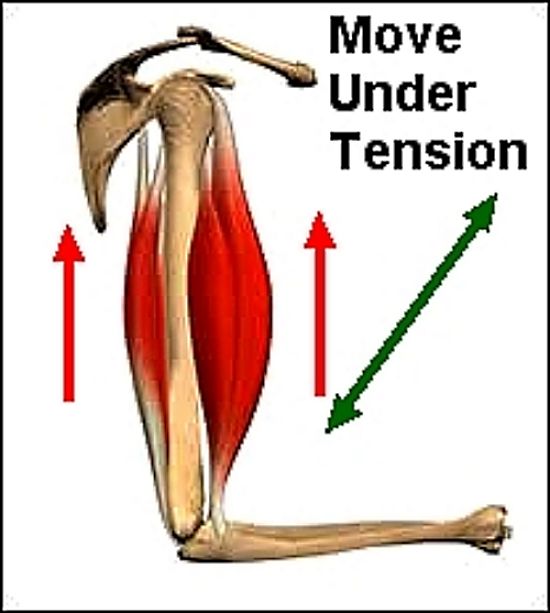
Dynamic tension is a very popular technique that has been used for various martial arts for thousands of years. It was popularised by the legendary Charles Atlas (who registered the name) who was the Godfather of Body Building in the West in the 1920s. His popular ads appeared on the back comic books and many people started body building using his techniques. However his methods combined high tension exercises with standard calisthenics to get better results. In some ways his methods are more related to modern isotonic or isometric exercises as he emphasised holding positions for long periods of time to develop static strength in various exercise positions, but without using weights.
What are the differences between dynamic tension, isotonic, isometric, pylometric and iso-dynamic exercises?
Dynamic Tension Exercises keep muscles and joints moving through an extension. The tension is intense and developed from opposing muscles such as those lifting and raising the arm working hard against each other. It can also be developed with arm muscles working against leg muscles, or with the entire set of muscles at the front and back of the body working against each other. With true Dynamic Tension exercises the movement is continued and the exercise is not static, although various positions can be held for several seconds. It is normally done slowly.
Static exercises are done when the muscles are worked without movement of the joints or muscles. Pushing against a wall or a heavy couch that does not move are examples of static exercises. The exercises can be done at various stages of a lift or pull, with position adjustments between sets. Static exercise improves strength, but it tends to increase blood pressure and because the muscles are not changing their length may interfere with proper blood circulation.
Isometric exercises or isometrics are exercises in which the muscle length and joint angle do not change during muscle contraction. The work is done against an immovable object or force such as a wall (overcoming isometric) or the joint and muscle is kept in a fixed position while the resistance is applied (yielding isometric). This can include work done by muscle contracting against another muscle but there is no net movement. This can include keeping a weight still when partially through a lift. In a yielding isometric the work applied is just sufficient not to overcome the resistance. Whereas in an overcoming exercise the force applied can be much larger as the object is unable to be moved.
Isotonic exercise involves muscle contraction applied to a fixed tension such as lifting an object at a constant speed. The muscle power increase to meet the resistance, then remains unchanged as the muscle shortens.
Isokinetic exercise in one in which the speed of movement is kept constant throughout the exercise. Plyometrics is a technique is used to increase the speed of movement or strength of muscular contractions, providing explosiveness in movements such as jumping. Muscles are pre-loaded and then contracted in rapid succession, using the strength and elasticity of muscles and tendons to increase speed, jumping ability or to throw farther, or hit harder.
What are Dynamic Tension Exercises
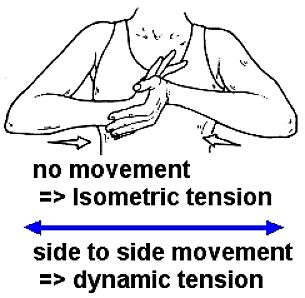
The basic concept for dynamic tension exercises is flexing your various muscles against each other to get a muscle workout without weights. As an example - extend you right hand out in front of your body like you are preparing to shake a person's hand, turn your palm downward, and then position your left hand below facing upward as shown in the diagram. This provides the set up for a dynamic tension biceps exercise. You simultaneously push downward hard with your right hand and push upward with your left hand. Your two sets of arm muscles oppose each other to generate resistance and tension. At the same time you move your arms from side to side for dynamic tension. Swapping hands will allow you to exercising your left bicep and right tricep.
Maintaining a high tension provides good exercise with little risk of injury because you are working your own muscles against each other. Doing this exercise with one arm and moving it across the body works the tricep against the bicep on the same arm that are tensioned against each other.
Using a similar technique you can go to a doorway and place your palms, facing outwards against the door frame and push outward very hard, while making slow movements from side to side. By tensing all your arm muscles this provides exercise for your whole arm and shoulder muscles, and shoulder blades (if you flex them).
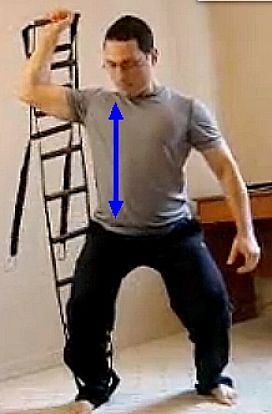
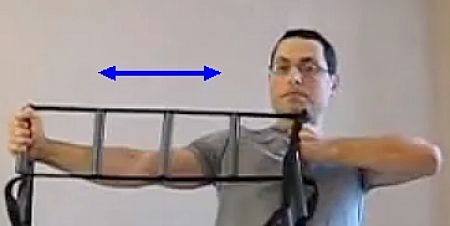
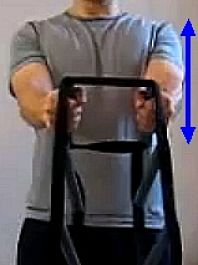
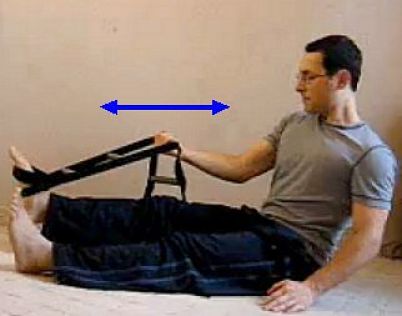
Further Examples of Dynamic Tension Exercises without Weights - Keep muscles tensioned while moving as shown
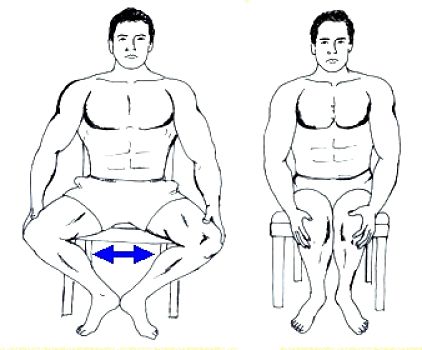
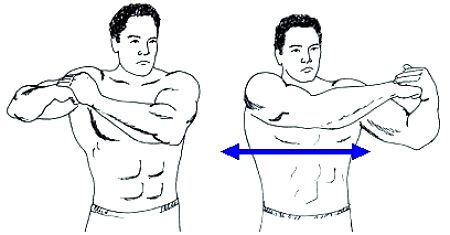
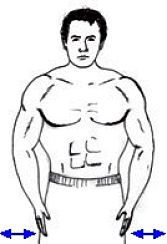
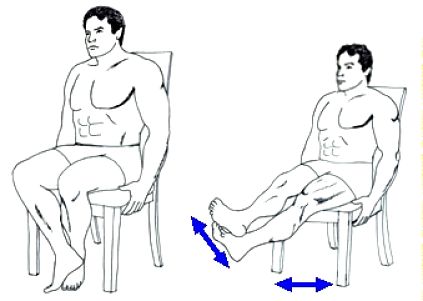
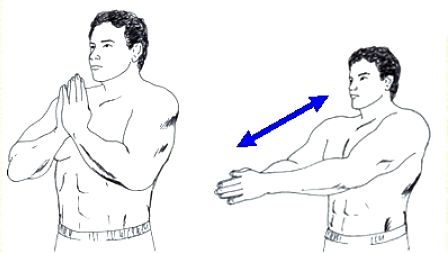
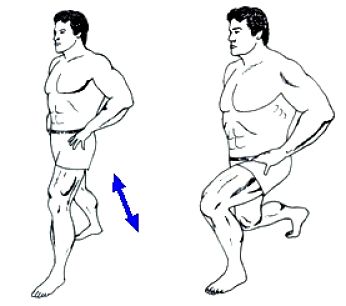
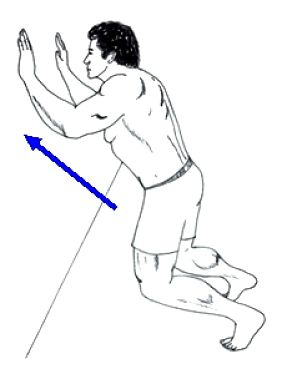
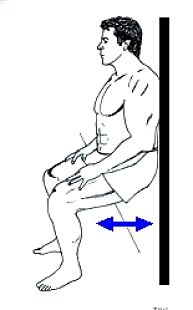
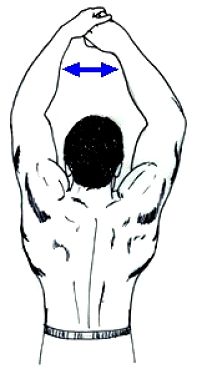
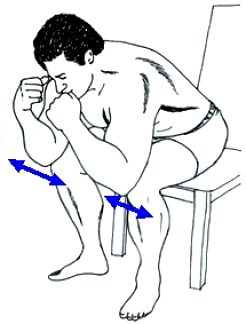
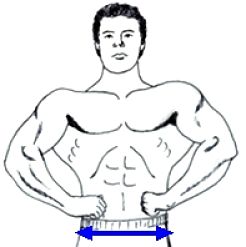
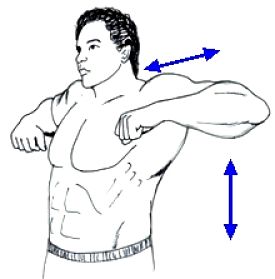
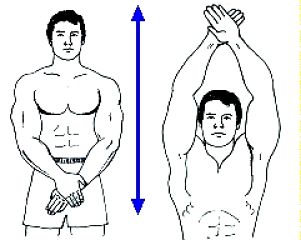
Using a loop of rope, ladder device(as shown), strap, towel, or a belt you can work your arms against your leg in a dynamic tension movement.
True Dynamic Tension as distinct from Isometric involves flexing the muscles hard while also moving through an extension. In the examples shown opposite the movement is shown by the blue arrows. Always provide high tension in the opposing muscles when doing the exercises. Many of the exercises can be done at home or work.
You can do a wide range of conventional exercises this way. For example, you can do your press-ups slowly developing tension by simultaneously flexing hard your pectorals, triceps, biceps, shoulders, and even your forearms and lats.
Maintain a high and steady tension while you do the press-ups.
It takes time and practice to get it right, but it is very worthwhile and it expands the muscles that are being exercised.
Do as many repetitions slowly as you can manage increasing the number of repeats as your strength and agility increases.
Guide and Tips for Dynamic Tension Exercises
Speed - The exercises should be done in a slow, smooth and coordinated way. For example you may take 1-4 seconds during each contraction and another 1-4 seconds for the subsequent extension. Work through a full cycle and full range of movement with all repetitions.
Mentally add more muscle fibres - At first it may be hard to apply a high tension. It helps if you mentally bring more and more of the muscle fibres into action on both sides.
Intensity - Continue each set of exercise to failure or exhaustion. Your first set will generally have many more repetitions than your last set. Always allow adequate recovery time between sets.
Duration - Most of these routine sets will require 20-30 minutes when you have developed the technique because the movements are done slowly.
Frequency - You generally should do these exercise about 3-4 times per week, allowing at least 24 hours rest between sessions. It is during the recovery periods when the strength and muscle development will occur.
Rest and Recovery - Allow only 45-60 seconds between each set as this increases the stress on the muscle fibres.
Risk of Injury - Many people argue that it is virtually impossible to be injured during these exercises because its muscles against muscle - but avoid jerky movements or moving too quickly.
Benefits of Isometric and Dynamic Tension Exercises
- Injuries are rare because as you get tired, the tension automatically decreases and its muscle against muscle
- These exercises are adaptable and require no equipment and can be done virtually anywhere and at any time. They can also be done by both men and women of all ages, strength and ability. They are good for rehabilitation.
- No equipment is required and you can use doorways, chairs and steps. If you like you can increase the tension with weights and resistance bands, especially with isometric exercises.
- You get good results and there is no excuse for not doing them - you don't have to go to the gym or make an appointment. It is easy to schedule them during your day at work or at home.
- You can increase the intensity or adapt the exercises into a gym program by using exercise equipment, hand weights, cables, rope ladders, resistance bands, a weight vest or another person's bodyweight. Charles Atlas probably used resistance training (resistance bands, cables, and hand weights) as part of his workout program.
Disadvantages and Conclusion
Each exercise system has it's own pros and cons and suits some people more than others.
Obviously with weights you can get injured in many ways such as pulling ligaments, drop the weights on your foot or crush a hand joint.
Weight or resistance band can strain or damage your joints by trying to lift too much weight or using the wrong form or technique.
Some people claim that Dynamic tension can raise your blood pressure too quickly.
Also because the muscles are held tensioned this may interfere with the blood flow to the muscles. This is probably more a risk with isometric exercises when there is no contraction and extension of the muscles.
However these exercise are very similar to lifting weights and using resistance bands.
Are they an adequate replacement for resistance exercises like pushups and weights? Probably not, but they are so convenient and adaptable and provide a lot of benefits with low risk of injury.
Isometrics and dynamic tension exercise are also not a replacement for cardiovascular or aerobic workouts even when they involve hundreds of fast repetitions.
But these exercises and an excellent addition to your workout program when time is limited or you’re away from the gym.
It suits many people who want to exercise at home and work and who don't want to go to the gym for various reasons.
Combining these exercise with walking, swimming and calisthenics can help provide a complete exercise program that will build muscle and help lose weight.
Related Articles
=> Resistance Band Exercise Routines, Pros and Cons, Tips and Guides
=> Homemade Sports Drinks for Revitalizing After Exercise
=> Exercise Intensity, Duration, Frequency are Vital for Fitness, Losing Weight
=> Watermelon Juice Relieves Post-Exercise Muscle Soreness, Other Health Benefits
=> How You Respond to Exercise – Some Do, Some Don’t, Depends on Genes
=> Training Plateau Definition - Great Tips for Breaking Through Exercise Plateaus and Barriers
=> Stretching Exercises Before a Run or Workout May NOT Reduce Injuries
=> How to Increase Your Vertical Jump - Best Exercises, Training Tips
=> Exercise Prolongs Life - Which Type, How Much and Best Intensity?
=> How to Beat the Set Point Limit in Daily Exercise Routines
=> Q&A: Why Does Exercise Makes You Feel Good & Improve Your Physical and Mental Health
=> Tight Hamstrings - Causes, Treatment and Exercises to Stretch, Loosen
=> Short Intense Exercise Routines for Men, Women - Something Old is New Again
=> Isometrics Exercising Equipment with Pressure App, Hand Exercise Ball